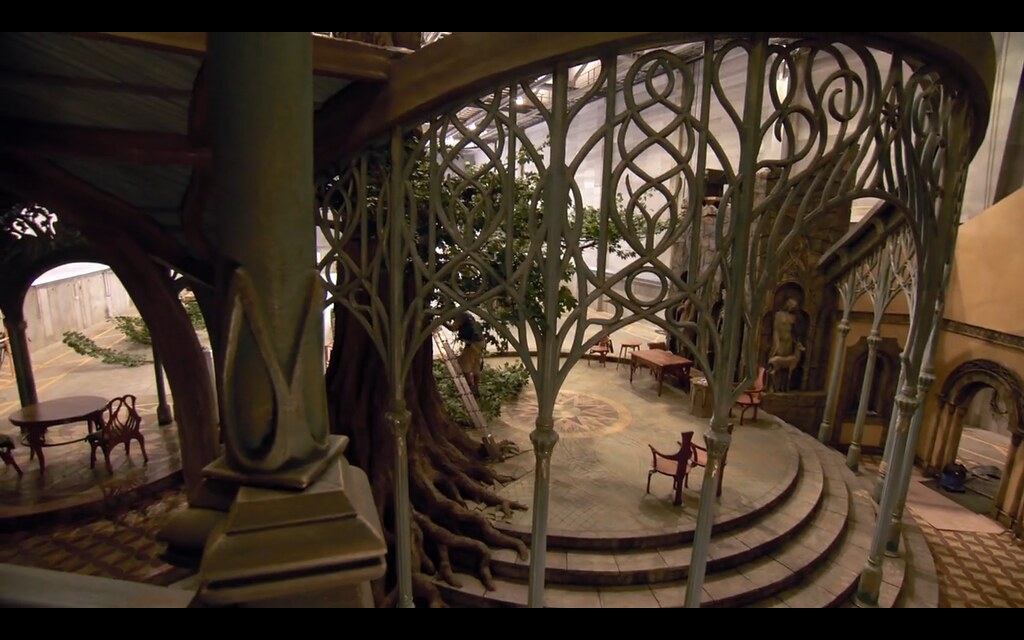[Incidentally, if there isn't a late twentieth century Role playing system called With Switchblade and Uzi, there ought to be.]
Your mind might turn to the Dragon Age games: the setting - the world of Theldas, draws from Medieval Europe (unlike Shadowrun). A certain section of the Elven population dwells in human cities, in ghettos known as Alienages. As you might expect, the friction between the two groups is greater than in other examples of fantasy games or books.
These are hardly the only examples of their kind. The Warhammer Fantasy pseudo-Atlantis of Ulthuan is filled with Elven cities. Tolkien himself describes Elven cities: Gondolin being perhaps the most famous. More recently, I understand the Netflix motion picture Bright to have linked elves very directly with twenty-first century Western affluence (the porcelain complexion elves have been often portrayed with being likely relevant).
I should like, however, to draw a line swiftly under these images. Let us discard the elf directly influenced by a twenty-first century conception of urban life; let us also put to one side the pure-Elven cities of high fantasy. A more cosmopolitan city (probably human-run) is brought for your consideration - one with Elven districts, rather than alienages or ghettoes.
However, these are still Elves on the Tolkien model. Long lived, skilful, thoughtful, graceful. What sort of communities might they build?
It might look a little like the Inns of Court, or an Oxbridge college. The comparison is made not in terms of social function, or professions of the inhabitants - though Elves could certainly be professors or barristers; an Elven judge doesn't just make precedent, he IS precedent.... [The notion of Elf-Rumpole must be quashed immediately.]
No, the comparison is made in terms of architecture and institutional process. The architectural angle suggests itself easily enough: relatively self-contained regions, well-madeplaces with wealth enough to keep them maintained (elves, even if not necessarily hugely wealthy, are presumably willing to work hard at keeping their homes up to scratch), cobblestones worn smooth and glossy by innumerably footsteps. The Gothic and Jacobean buildings possessed by some of Inns of Court or colleges are fitting: Peter Jackson's cinematic adaptation of Lord of the Rings uses a sort of Gothic revival style for Elven buildings, focussing on the naturalistic features of Gothic architecture and snipping away any very bright colours. (Although this gentleman makes the comparison to Art Nouveau).
(Incidentally, I am not suggesting that Oxbridge colleges or the Inns of Court have always been neat, clean, 'Elf-worthy' spots. In the days of Dr Johnson and Oliver Goldsmith, for instance, I am by no means sure that the Temple was.)
[I have discussed the Arts and Crafts movement, roughly contemperenous with the Gothic revival here - this article may be considered a companion piece of sorts.]
 |
| From Peter Jackson's The Lord of the Rings. Consider that tracery; other views available here. The pillars and colonnades in this clip are also a good from the Gothic revival point of view, though the painted artwork is rather more naturalistic than below - and the arches less pointed. |
Consider for comparison...
 |
| Interior, All Saints' Church, Cambridge (Image from Wikipedia) |
 |
| Interior, All Saints, Margaret Street, London - once again from Wikipedia. |
Of course, Elven architecture would be less ecclesiastical (if not, however, irreligious). The images of Rivendell above also have something of the vernacular about them (Cf. Dragestil). Perhaps Gothic revival Elves or Oxford Movement Elves are something for another day.
One could also have Elves take up a more Classical or Georgian form - in which case perhaps an Elven community might look like New Town, Edinburgh next to the cramped tenements around the Castle and crags. However, enough of architecture for a time.
Let us also think on the nature of the institutions referenced above. Old fashioned in certain regards. Wealthy, if not as wealthy as corporations - and with a less profit-driven motive (regardless of how much money gets made). Prestigious and influential, certainly - bur prestige and influence not based on raw power or numbers or deep coffers. (Wizards often get the University model thrust towards them in fantasy fiction - but I feel Elves could have it attributed to them successfully).
Elves don't strike me as terribly antisocial: capable of being alone and prospering, certainly. But the notion that they would adhere to one another in the metropolis - so that one might have of refuge from the follies and transience of the human life (without the Elves in question actively despising humanity - those that do like as not stay in the forest or the isles).
Moreover, if one were to ask after the foundation of such a place it might be that the courts and gardens of the Elven Quarter were built after they had been exiled, when the Dark Lord occupied the forests of the Verdant Dale...(&c.). Migrations into cities for Tolkien-esque Elves does not seem a process that would occur naturally.
I bear no grudge to Shadowrun or Bright. But here is a vision not of the Urban fantasy sub-genre, though it is firmly based in the city - hence the title I have used here, Civic Elves. Elves in the city not entirely divorced from their roots in Tolkien - or indeed his inspirations.
No comments:
Post a Comment